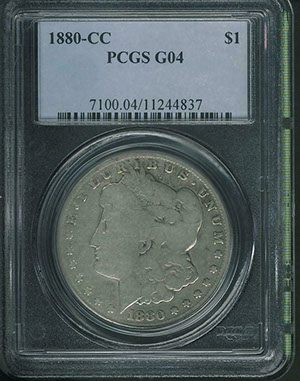
May 2021 - Welcome
Sources
Search
Contact
Home
Welcome
Click on year to expand
2022
2021
2020
2019
2018
2017
2016
2015
Welcome
Living Quarters
Crossing Paths
This month we are delving into the life of the fourth Mint Supervisor, Charles F. Bienvenu. As with his three predecessors, his story has its twists and turns.
We are also getting back to the work of identifying die cracks and filling in the blanks for the VAMs we have.
![]()
![]() LVA Submissions
LVA Submissions
We have five coins to send to Leroy for analysis and that needs to get going again now that Leroy seems to be taking submissions.
![]()
![]() VSS Submissions
VSS Submissions
We have twenty coins to send to JB for VAM analysis and photography, but like everyone else the world seems to be in slow motion right now.
New Orleans Supervisors
1837 - 1839 David M. Bradford
1839 - 1850 Joseph M. Kennedy
1850 - 1852 Robert M. McAlpin
1853 - 1857 Charles F. Bienvenu
![]()
Charles Bienvenu shows up as the Superintendent of the New Orleans Mint with the 1853 Congressional appointments. They list him as a Louisiana native, so surely there is some political intrigue to his replacing McAlpin.
In the book on Numismatic Biographies available at the Newman Portal he is listed as a State Legislator, Attorney, and Superintendent of the Mint. So we know he had political connections that would have spanned various branches of government. He was appointed to the superintendents post during the administration of Franklin Pierce, a Democrat who took office in 1853 from Milliard Fillmore, a Whig.
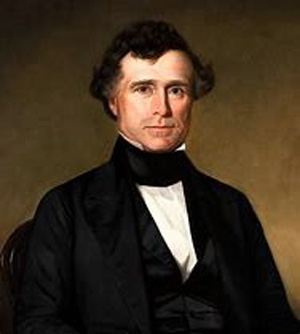
Franklin Pierce
He was appointed on April 6, 1853 by the President with the notation "Robert M. McAlpin, removed." Since this wording is consistent with all appointments we would assume the "removed" means nothing more than terms were up and there was a change of the party in power. We have no indication that McAlpin was removed for cause, just in the wrong party.
Further evidence of Bienvenu's party affiliation can be seen with his exodus from the job. His tenure lasted from 1853 to 1857 and corresponds to the term of Franklin Pierce. He is still listed in the Federal Register in 1857, but we know this was his last year of service.
To our knowledge no picture of Charles F. Bienvenu survives, which is a bit strange since politicians love to have their picture taken.
![]()
Bienvenu Family
Assuming our research to be correct, his full name was Charles Fierville Bienvenu, born in 1782 and living with his wife and two children in New Orleans in the 1860 census. We believe this is further confirmation of his identification because in the 1860 census his son, Charles, was 30 years old and listed as a Mint employee.
The elder Charles Bienvenu died later in December 1860, so the Mint employment was becoming the family business, or at least a career path. His son, Charles, was also listed as an attorney in the 1861 New Orleans city directory. In one reference he is shown as the Treasurer Policy Jury, which is the person responsible for disbursing all funds for a Parrish in Louisiana.
Also of interest with the elder Charles Bienvenu is additional Federal Census data showing that he owned considerable land and was a planter or farmer. His wealth is shown to be in the $40,000 range which would have been substantial. But living in New Orleans and owning substantial farms made him a wealthy absentee owner and probably a person of influence in New Orleans.
![]()
Whether or not the Bienvenu family occupied the personal quarters at the Mint is unknown, but this month we have uncovered some additional information about those quarters that sheds light on how this was tolerable to the families.
 New Orleans Mint (click to enlarge)
New Orleans Mint (click to enlarge)
For years we have pondered just how the families of Mint officials could have tolerated the noise and vibration associated with coining while living at the Mint. In a speech given by Brigadier General Allison Owen on October 12, 1931 to the New Orleans Historical Society he references two important items.
The picture above shows the Mint building as it probably looked in the late 1800's. Notice the decorative wrought iron balcony on the second floor, east end of the building. We doubt it is ever cool in New Orleans, but for sure the east end of the building would have been the more pleasant weather wise, and this balcony is outside the residential apartments.
From General Owen's speech we learn :
"By the way, it may be interesting to say here that the coiner, melter and several officers had their living quarters in the wings of the building. The iron veranda on the river-end served the coiners' suit. There are accounts of balls and parties given by them in the building in the early days to which time has added a glamour which makes them quite romantic. The last to live in the building were ordered out in 1888."
The reference to balls and parties probably is specific to the flamboyant Kennedy family we discussed earlier in our research. The 1888 date is important because this would mean that post Civil War when the Mint reopened the Mint officers were still offered quarters and this spans well into Morgan Dollar era.
Further into his speech we learn that:
"Beside the seven or eight vaults in the building for bullion and money, the whole of the ground floor of the river-end wing was a very large vault with the door opening into [the] yard. It was in this vault that some six or seven million silver dollars were until recently stored. It took several days to remove this huge quantity of money, which had been in storage so long that the lower sacks fell to pieces when handled."
So the quarters for the Mint Officers and their families would have been over these large vaults and in the quieter portion of the building.
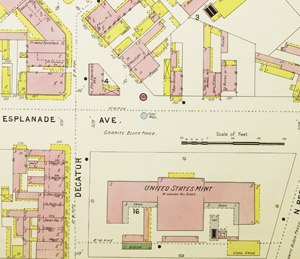 Historical Fire Map (click to enlarge)
Historical Fire Map (click to enlarge)
From this fire map the residential balcony is marked in yellow with a 2.
![]()
1856 Mint Repairs
We know the Mint at New Orleans was build on not so good ground and suffered many structural issues. By a strange twist of events, the Mint was examined and determined that it needed structural improvements, so in 1856 it was determined that significant repairs should be made. This placed Charles Bienvenu at the center of a management challenge to continue production while structural repairs were made. A big focus for the repairs was to make the building fireproof, and we know the timber roof rafters were replaced with cast iron to achieve this fireproofing.
But many other issues were addressed such as the foundation for the large chimney used in production operations. As with many construction projects on old buildings, one repair leads to another and there was a significant cost overrun that required additional approvals from Washington. And of course there were charges of mismanagement and Congressional hearings which led to nothing (imagine that).
From 1853 to 1856 the production of both silver and gold coins declined at the Mint. This may have been from structural issues, just bullion availability, or mismanagement.
Interestingly, the engineer who determined that repairs were needed was none other than Major P. G. T. Beauregard, who was a government engineer at the time and worked on both the Customhouse and Mint structural issues in New Orleans.
![]()
If you are familiar with the concept of "Six degrees of separation" then the crossing of paths in New Orleans will not be surprising. We will have more on this next month, but we have to remember that many if not most officers of the Confederacy were either U. S. Military members or other Government officials, some elected and some appointed.
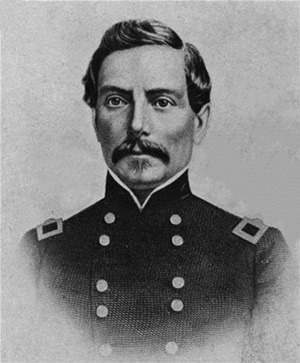 P. G. T. Beauregard - U. S. Army
P. G. T. Beauregard - U. S. Army
Pierre Gustave Toutant-Beauregard has the claim to fame of being the man in charge when Confederate forces fired on Fort Sumter in Charleston, but went on to command the defenses at New Orleans. During the war he fought in many major campaigns and was a highly regarded officer. He was a West Point graduate and served briefly as the superintendent. In the U. S. Army he served with distinction during the Mexican-American War. In that war he fought with President Pierce who appointed him as superintending engineer of the U. S. Customhouse in New Orleans where he enters this story. The Customhouse had the same structural issues as the Mint and he was charged with solving both issues.
![]()
 Howell Cobb - Pre Civil War
Howell Cobb - Pre Civil War
Howell Cobb was a lawyer, the 40th Governor of Georgia, a five term member of the House of Representatives and at one time Speaker of the House. He also was the Secretary of the Treasury under President Buchanan. Once the southern states seceded he became the President of the Confederate States Provisional Congress. Cobb opposed secession prior to Lincoln's election, but quickly changed his opinion and resigned as Secretary of the Treasury in 1860. If not for the Civil War he would have been a U. S. Presidential candidate following President Buchanan. More on him next month as we lead up to the War.
A Cipher Just for Fun
Coming out of Covid 19 restrictions I figured we might all need a little something else to focus on. So I have decided to give away an 1880-CC PCGS G04 to the first person who can break this cipher. (I only have one of these, so I cannot do more than one.) I believe it is a VAM 3A, but as you know I stick to the 1881-O, so no guarantees.
The cipher is a word cipher based on one of the most famous documents in our Nation's history. There is no punctuation in the solution, just a series of words that might or might not have a little meaning in the world of VAM's.
Your spelling must be EXACT and the word order EXACT to win. When you have the solution just message it to me at VAMworld or my external email address.
I have checked this about ten times, so it should be accurate, but if I (or you) discover an error I will post it here.
The Cipher Is
16 23 148 367 281 346 363 93 90 150 144 169 8 87 1208 398 38 68 217 40 467
![]()
Die Fingerprint Study
This month we are looking at VAMs 15, 41, 51, 71, 17, and 19 for die cracks. We have to remind ourselves that finding no cracks is just as helpful sometimes as finding cracks because it groups coins by characteristics.
To see our overall progress with this study CLICK HERE.
VAM 15 - Doubled 1
VAM 15 is one where we have a lot of material, twenty-six coins, and none of them show any die cracks. We even have several toned coins where the color often reveals cracks and even those lack any cracks or breaks. Fortunately this is a VAM where the identification of the specific detail of the right 1 is sufficient. This is coin certificate 33193603, an MS64 example.

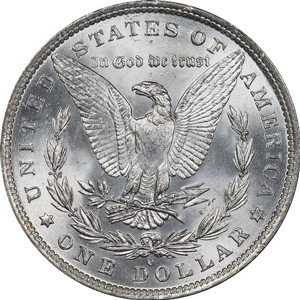
VAM 15 shares Obverse Die 7 with VAM 41, but a different reverse. See the matrix page here.
![]()
VAM 41 - Doubled 1, Tripled Left Wreath, Doubled Legend
VAM 41 is not rare, but not one where a lot of examples have shown up. Our collection contains nine examples, most of which are mint state, so a lot to work with in this study. We have only one toned coin in the group. Fortunately this is a VAM where the identification of the specific detail for both the obverse and reverse are not dependent on die cracks since the die features are easily distinguishable. This is coin certificate 14175891, an MS64 example. As with VAM 15, there are no die cracks on any of our mint state coins.
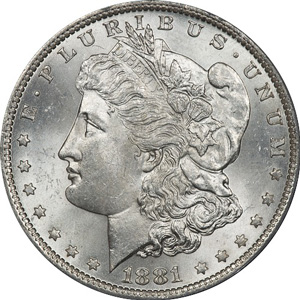
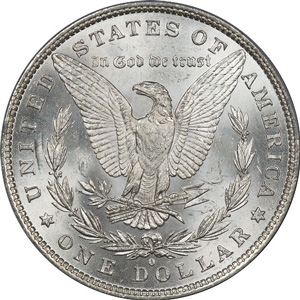
VAM 41 shares Obverse Die 7 with VAM 15, but a different Reverse Die p. See the matrix page here.
![]()
VAM 51 - Doubled 1, Tripled Left Wreath, Doubled Legend, Clashed Obverse us
VAM 51 is not common and not one where a lot of examples have shown up in mint state. Our collection contains five examples. This can be a coin that is difficult for us to identify because the obverse letter clashing is difficult to see. Fortunately the other VAM identification points are somewhat obvious so die cracks help, but may not be needed. This is coin certificate 33025127, an AU58 example.

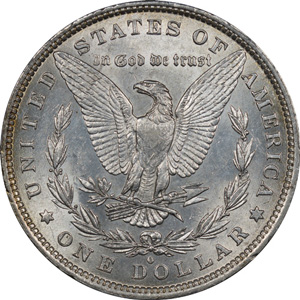
VAM 51 shares Obverse Die 15 with VAMs 26 and 26A, but shares Reverse Die p with VAMs 41 and 71. See the matrix page here.
![]()
VAM 71 - Doubled 18-1, Tripled Left Wreath, Doubled Legend, O Tilted Left
VAM 71 is not common and only one has a 100% positive ID, our discovery coin. Our discovery coin has not been graded yet and is encapsulated by VSS only at this time.
Die cracks toward the rim are common but when we see them toward the center devices it certainly indicates a greater degree of die wear.
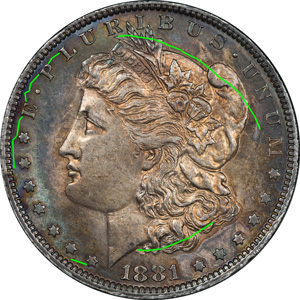

VAM 71 has a unique Obverse Die 48 that seems to be a unique pairing at this time. Reverse Die p is shared with VAMs 51 and 71. See the matrix page here.
![]()
VAM 17 - Dash Under 8
VAM 17 is one where we have a lot of material, thirty-two higher grade coins, and none of them show any die cracks. We have several deeply toned coins where the color can reveals cracks and even those lack any cracks or breaks. This probably makes sense since the dash is a faint feature and would wear away quickly. Our collection ranges from XF45 to MS65, and below those grades the feature may be gone.
This is a VAM where the identification of the specific detail under the right 8 is unique and easily identified. But the dash can be faint and you need to catch it in the right light and at the right angle to see it. This is coin certificate 84162147, an MS65 example.


VAM 17 shares Obverse Die 9 with no other VAMs, and the reverse is a featureless die a. See the matrix page here.
![]()
VAM 19 - Doubled 1--1 & Profile
VAM 19 is often found in mint state and we have only one coin below mint state, so plenty of material to work with. In total we have 14 examples of VAM 19. There is one toned coin, which can help, but for the most part these are clean uncirculated examples.
This is a great example to study because of the clean strike on the obverse where the only differentiating factor is bag damage. The fields of the obverse are often reflective, even approaching PL or DMPL level.
The reverse of the coin does show some die cracks, indicating that this pairing is of dies in different states of wear. This is coin certificate 84021273, an MS63 example. But the die cracks are superficial, so the die probably had a life beyond this striking.
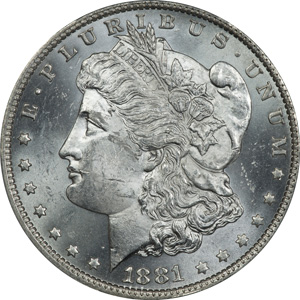
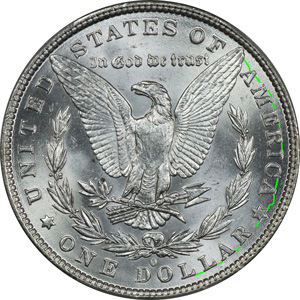
VAM 19 uses Obverse Die 11 which is unique at this stage of study. The Reverse Die is another Die a. See the matrix page here.
![]()
Getting Started
Collecting The 1881-O
The 1881-O VAMs





















